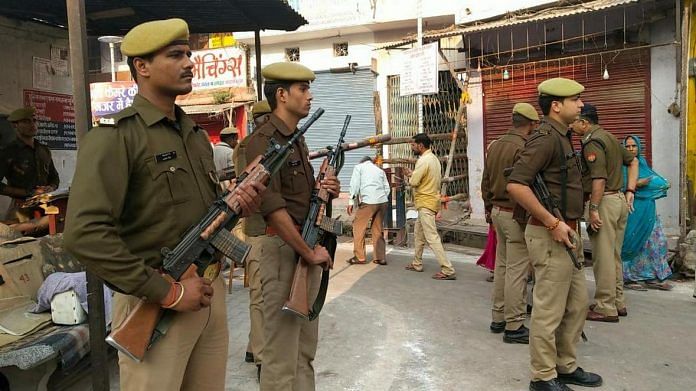When the Supreme Court delivered its big punchline ordering the central government to set up a trust for the construction of Ram Temple at the disputed site in Ayodhya and allot five acres of land for a mosque, it gave clear indications that its verdict in the decades-old Ram Janmabhoomi-Babri Masjid title dispute is a fine balancing act.
The five-judge Constitution bench headed by Chief Justice of India Ranjan Gogoi made all the right noises. It ruled that the suit filed by Nirmohi Akhara was barred by limitation; it also rejected the Nirmohi Akhara’s claim of being the shebait (devotee of the deity Ram Lalla); and it held that while Ram Janmabhoomi has no juristic personality, Ram Lalla was a juristic person with legal rights.
It also ruled there was little doubt that the disputed site in Ayodhya was used by devotees of both communities to offer prayers.
And then, the Supreme Court decided to grant the land to Hindus.
Also read: SC invoked Article 142 to order formation of trust for Ram Mandir. Here’s what it means
Pleasing all parties
While only a careful reading of the bench’s 1,045-page unanimous judgment could clear how it concluded that it was constitutionally tenable to grant the disputed land to Hindus for the construction of a temple but not to Muslims, what is clear at the moment is that the Supreme Court has tried to give something to all the parties involved.
But the court’s please-all effort may not entirely please all the sides, especially Muslims, represented by the All India Muslim Personal Law Board and the Sunni Waqf Board. They have already said they aren’t “completely satisfied” with the Ayodhya verdict and may file a review petition. But despite this, the verdict could still be the closure that India needs to settle one of its oldest and most controversial religious disputes in history.
It is also interesting to note that there’s no clue to the identity of the judge who penned the addendum to record “separate reasons” on “whether the disputed structure is the birth-place of Lord Ram according to the faith and belief of the Hindu devotees”.
While students of law always look for infirmities in court judgments, the one on Ayodhya may actually be the only way to settle the dispute peacefully, even if it means pandering to the majority.
American jurist Robert H. Jackson once said, “There is no doubt that if there were a super-Supreme Court, a substantial proportion of our reversals of state courts would also be reversed. We are not final because we are infallible, but we are infallible only because we are final.” This quote fittingly holds up while trying to understand the Ayodhya verdict.
Also read: Can the Supreme Court’s Ayodhya verdict bring closure?
Reading the Ayodhya verdict
When the bench writes in its judgment that “the accounts of the travellers must be read with introspection” and that “the court must be circumspect in drawing negative inferences from what a traveller may not have seen or observed”, one wonders then how the Supreme Court established that it could not award the disputed site to Muslims.
Or why it couldn’t agree with the judgment of the Allahabad High Court granting two parts of the disputed site to Hindus and one to Muslims. After all, the Supreme Court did hold in its ruling that the demolished Babri Masjid was not abandoned – that the mere cessation of namaz by Muslims cannot lead to the inference that the mosque was abandoned – and so have lost possession. It did say that “while the Hindus had continued to offer worship continuously in the outer courtyard, there was no abandonment of the claim by the Muslims of the status of the structure inside the inner courtyard as a mosque”.
The answer is provided by the Supreme Court itself and it is also the key to understanding the Ayodhya judgment.
“We have already concluded that the three-way bifurcation by the High Court was legally unsustainable. Even as a matter of maintaining public peace and tranquillity, the solution which commended itself to the High Court is not feasible. The disputed site admeasures all of 1500 square yards. Dividing the land will not subserve the interest of either of the parties or secure a lasting sense of peace and tranquillity,” the bench ruled.
Maintaining public peace and tranquillity, it can be said, is why the Supreme Court has done what it did today with its Ayodhya verdict.
The author is a senior journalist. Views are personal.




With the premise the Supreme Court of India delivered the judgment in Ayodhya, it has officially templed on the preamble of the constitution by voluntary succumbing to Majoritarian political pressure.
Otherwise if an controversial Archeological data is a key evidence to support a mythological religious beliefs to demolish a place of worship one religion with another religion, the Judiciary is truly proving it self as part and parcel of majoritarian communal political ideology. I wonder even the acquisition of 2.4 acres of land around Ram Chabutra by the Govt. is pre planned strategy.
Please read as trampled in place of templed…
Allah is a arab mythological drama, even there is no proof of Arab being prophet.
Today TheWire.in is propagating lies even after the SC verdict. It is trying to provoke the readers by publishing one article after another on Babur, victimhood, deploring peace appeal by leaders and provocative images depicting only one side of dispute. A caption ‘Once there was a Mosque’ is diplayed prominently.
We need to condemn its ulterior motives unanimously.